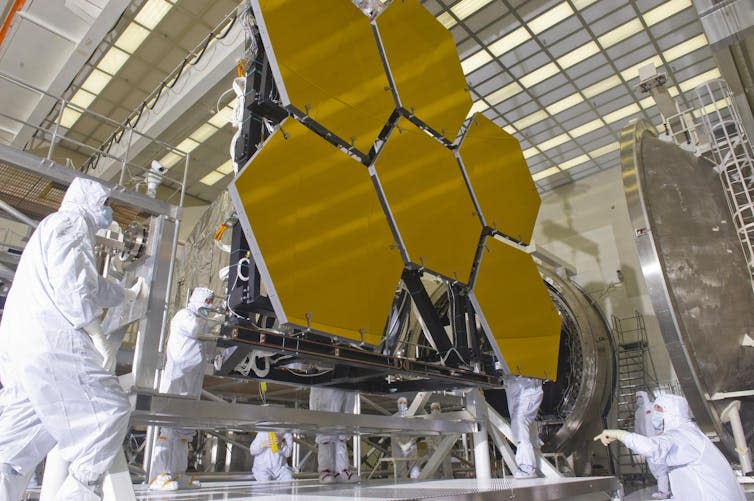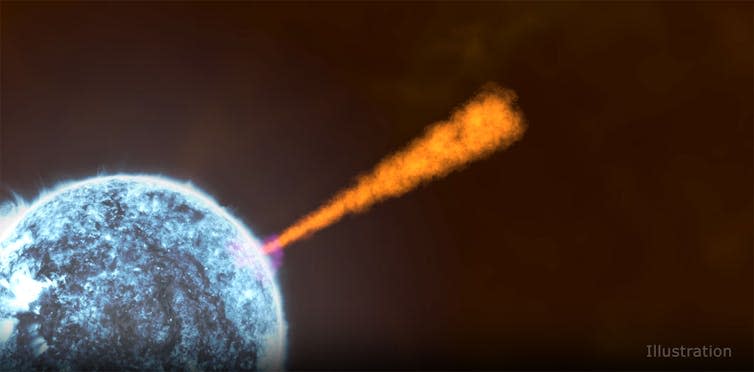After its “birth” in the Big Bang, the universe consisted mainly of hydrogen and a few helium atoms. These are the lightest elements in the periodic table. In the 13.8 billion years from the Big Bang to the present, almost all elements heavier than helium have been produced.
Stars produced most of these heavy elements through the process of nuclear fusion. However, this leaves the elements only as heavy as iron. Creating heavier elements will consume energy rather than release it.
In order to explain the existence of these heavy elements today, it is necessary to find the phenomena that can produce them. One type of event that fits this bill is the gamma-ray burst (GRB), the most powerful class of explosion in the universe. These can explode at magnitudes of quintillion (10 followed by 18 zeros) times the luminosity of our Sun and are thought to result from various types of events.
GRBs can be divided into two categories: long bursts and short bursts. Long GRBs are associated with the death of massive and rapidly rotating stars. According to this theory, fast-spinning beams of material are ejected during the collapse of a massive star and turn into narrow jets moving at extremely high speeds.

Short bursts last only a few seconds. These are thought to result from the collision of two neutron stars (compacted and dense “dead” stars). A significant event in August 2017 helped support this theory. Ligo and Virgo, two gravitational wave detectors in the US, have discovered a signal that appears to be coming from two neutron stars moving to collide.
A few seconds later, a short gamma-ray burst known as GRB 100817A was detected coming from the same direction in the sky. For several weeks, nearly every telescope on the planet was pointing at this event in an unprecedented effort to study its aftermath.
Observations revealed a kilonova at the location of GRB 170817A. A kilonova is a fainter cousin of a supernova explosion. Even more interesting, there was evidence that many heavy elements were produced during the explosion. Authors of a study analyzing the explosion in the journal Nature showed that this kilonova produced two different categories of debris, or ejecta. One consisted primarily of light elements and the other consisted of heavy elements.
We have previously stated that nuclear fission can only produce elements as heavy as iron in the periodic table. But there is another process that could explain how kilonovae can produce heavier ones.
The fast neutron capture process, or r-process, is where the nuclei (or nuclei) of heavier elements such as iron capture many neutron particles in a short time. They then rapidly grow in mass, producing much heavier elements. But for the r-process to work, you need the right conditions: high density, high temperature and lots of free neutrons. To provide these necessary conditions, gamma ray bursts occur.
However, mergers of two neutron stars, such as the one that caused the kilonova GRB 170817A, are very rare events. In fact, they may be rare enough to make them an unlikely source of heavy elements that are abundant in the universe. What about long GRBs?


A recent study investigated one long gamma-ray burst in particular, GRB 221009. This was called BOAT, the brightest of all time. This GRB was captured on October 9, 2022 as an intense pulse of radiation spreading throughout the Solar System.
BOAT sparked a kilonova-like astronomical observing campaign. This GRB was 10 times more energetic than the previous record holder and was so close to us that its impact on the Earth’s atmosphere could be measured on the ground and was comparable to a major solar storm.
Among the telescopes examining BOAT’s aftermath was the James Webb Space Telescope (JWST). To avoid being blinded by the afterglow of the initial explosion, he observed the GRB about six months after the explosion. Data collected by JWST showed that despite the extraordinary brightness of the event, it was caused by only an average supernova explosion.
In fact, previous observations of other elongated GRBs showed that there is no correlation between the luminosity of the GRB and the size of its associated supernova explosion. BOAT does not seem to be an exception.
The JWST team also deduced the number of heavy elements produced during the BOAT explosion. They found no indication of elements produced by the R-process. This is surprising because theoretically the brightness of a long GRB is thought to be associated with conditions at its core, most likely a black hole. For very bright events, especially events as extreme as BOAT, conditions must be suitable for the r-process to occur.
These findings suggest that gamma-ray bursts may not be the major hoped-for source of heavy elements in the universe. Instead there must still be a resource or resources there.
This article is republished from The Conversation under a Creative Commons license. Read the original article.


Robert Brose does not work for, consult, own shares in, or receive funding from any company or organization that would benefit from this article, and has disclosed no relevant affiliations beyond his academic duties.